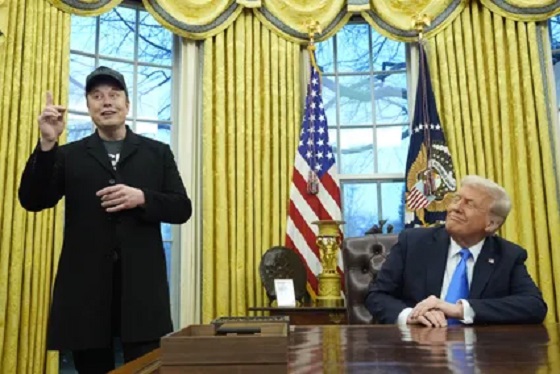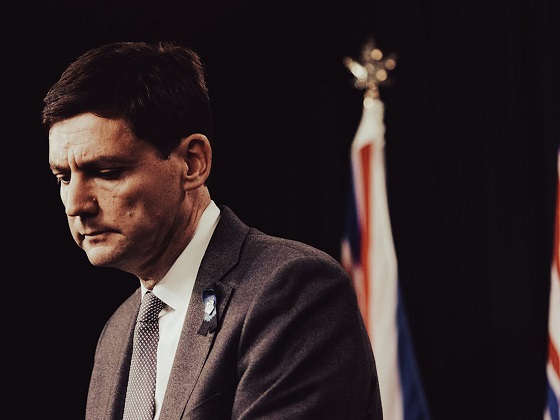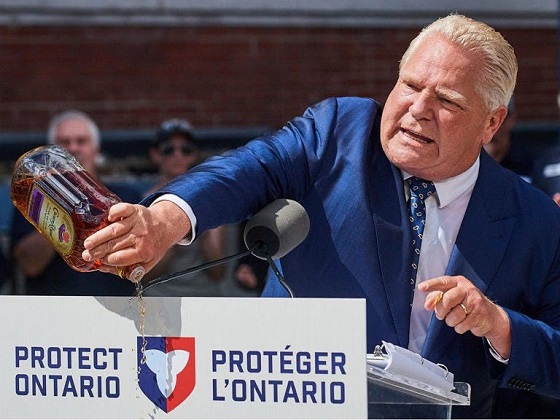Economy
Number of newcomers to Canada set to drop significantly

From the Fraser Institute
Late last year, Statistics Canada reported that Canada’s population reached 41.5 million in October, up 177,000 from July 2024. Over the preceding 12 months, the population rose at a 2.3 per cent pace, indicating some deceleration from previous quarters. International migration accounts for virtually 100 per cent of the population gain. This includes a mix of permanent immigrants and large numbers of “non-permanent residents” (NPRs) most of whom are here on time-limited work or student visas.
The recent easing of population growth mainly reflects a slowdown in non-permanent immigration, after a period of increases with little apparent oversight or control by government officials. The dramatic jump in NPRs played a key role in pushing Canada’s population growth rate to near record levels in 2023 and the first half of 2024.
Amid this demographic surge, a public and political backlash developed, due to concerns that Canada’s skyrocketing population has aggravated the housing affordability and supply crisis and put significant pressure on government services and infrastructure. In addition, the softening labour market has been unable to create enough jobs to employ the torrent of newcomers, leading to a steadily higher unemployment rate over the last year.
In response, the Trudeau government belatedly announced a revised “immigration plan” intended to scale back inflows. Permanent immigration is being trimmed from 500,000 a year to less than 400,000. At the same time, the number of work and study visas will be substantially reduced. Ottawa also pledges to speed the departure of temporary immigrants whose visas have expired or will soon.
Remarkably, NPRs now comprise 7.3 per cent of the country’s population, a far higher share than in the past. The government has promised to bring this down to 5 per cent by 2027, which equates to arranging for some two million NPRs to depart when their visas expire. There are doubts that our creaking immigration and border protection machinery can deliver on these commitments. Many NPRs with expired visas may seek to stay. That said, the total number of newcomers landing in Canada is set to drop significantly.
According to the government, this will cause the country’s total population to shrink in 2025-2026, something that has rarely happened before.
Even if Ottawa falls short of hitting its revised immigration goals, a period of much lower population growth lies ahead. However, this will pose its own economic challenges. A fast-expanding population has been the dominant factor keeping Canada’s economy afloat over the last few years, as productivity—the other source of long-term economic growth—has stagnated and business investment has remained sluggish. It’s also important to recognize that per-person GDP—a broad measure of living standards—has been declining as economic growth has lagged behind Canada’s rapid population growth. Now, as the government curbs permanent immigrant numbers and sharply reduces the pool of NPRs, this impetus to economic growth will suddenly diminish.
However, Canada will continue to have high levels of immigration compared to peer jurisdictions. The lowered targets for permanent immigration—395,000 in 2025, followed by 380,000 and 365,000 in the following two years—are still above pre-pandemic benchmarks. This underscores the continued importance of immigration to Canada’s economic and political future.
Instead of obsessing about near-term targets, policymakers should think about how to ensure that immigration can advance Canada’s prosperity and provide benefits to both the existing population and those who come here.
Jock Finlayson
Senior Fellow, Fraser Institute
Banks
Bank of Canada Cuts Rates to 2.25%, Warns of Structural Economic Damage

Governor Tiff Macklem concedes the downturn runs deeper than a business cycle, citing trade wars, weak investment, and fading population growth as permanent drags on Canada’s economy.
In an extraordinary press conference on October 29th, 2025, Bank of Canada Governor Tiff Macklem stood before reporters in Ottawa and calmly described what most Canadians have already been feeling for months: the economy is unraveling. But don’t expect him to say it in plain language. The central bank’s message was buried beneath bureaucratic doublespeak, carefully manicured forecasts, and bilingual spin. Strip that all away, and here’s what’s really going on: the Canadian economy has been gutted by a combination of political mismanagement, trade dependence, and a collapsing growth model based on mass immigration. The central bank knows it. The data proves it. And yet no one dares to say the quiet part out loud.
Start with the headline: the Bank of Canada cut interest rates by 25 basis points, bringing the policy rate down to 2.25%, its second consecutive cut and part of a 100 basis point easing campaign this year. That alone should tell you something is wrong. You don’t slash rates in a healthy economy. You do it when there’s pain. And there is. Canada’s GDP contracted by 1.6% in the second quarter of 2025. Exports are collapsing, investment is weak, and the unemployment rate is stuck at 7.1%, the highest non-pandemic level since 2016.
Macklem admitted it: “This is more than a cyclical downturn. It’s a structural adjustment. The U.S. trade conflict has diminished Canada’s economic prospects. The structural damage caused by tariffs is reducing the productive capacity of the economy.” That’s not just spin—that’s an admission of failure. A major trading nation like Canada has built its economic engine around exports, and now, thanks to years of reckless dependence on U.S. markets and zero effort to diversify, it’s all coming apart.
And don’t miss the implications of that phrase “structural adjustment.” It means the damage is permanent. Not temporary. Not fixable with a couple of rate cuts. Permanent. In fact, the Bank’s own Monetary Policy Report says that by the end of 2026, GDP will be 1.5% lower than it was forecast back in January. Half of that hit comes from a loss in potential output. The other half is just plain weak demand. And the reason that demand is weak? Because the federal government is finally dialing back the immigration faucet it’s been using for years to artificially inflate GDP growth.
The Bank doesn’t call it “propping up” GDP. But the facts are unavoidable. In its MPR, the Bank explicitly ties the coming consumption slowdown to a sharp drop in population growth: “Population growth is a key factor behind this expected slowdown, driven by government policies designed to reduce the inflow of newcomers. Population growth is assumed to slow to average 0.5% over 2026 and 2027.” That’s down from 3.3% just a year ago. So what was driving GDP all this time? People. Not productivity. Not innovation. Not exports. People.
And now that the government has finally acknowledged the political backlash of dumping half a million new residents a year into an overstretched housing market, the so-called “growth” is vanishing. It wasn’t real. It was demographic window dressing. Macklem admitted as much during the press conference when he said: “If you’ve got fewer new consumers in the economy, you’re going to get less consumption growth.” That’s about as close as a central banker gets to saying: we were faking it.
And yet despite all of this, the Bank still clings to its bureaucratic playbook. When asked whether Canada is heading into a recession, Macklem hedged: “Our outlook has growth resuming… but we expect that growth to be very modest… We could get two negative quarters. That’s not our forecast, but we can’t rule it out.” Translation: It’s already here, but we’re not going to admit it until StatsCan confirms it six months late.
Worse still, when reporters pressed him on what could lift the economy out of the ditch, he passed the buck. “Monetary policy can’t undo the damage caused by tariffs. It can’t target the hard-hit sectors. It can’t find new markets for companies. It can’t reconfigure supply chains.” So what can it do? “Mitigate spillovers,” Macklem says. That’s central banker code for “stand back and pray.”
So where’s the recovery supposed to come from? The Bank pins its hopes on a moderate rebound in exports, a bit of resilience in household consumption, and “ongoing government spending.” There it is. More public sector lifelines. More debt. More Ottawa Band-Aids.
And looming behind all of this is the elephant in the room: U.S. trade policy. The Bank explicitly warns that the situation could worsen depending on the outcome of next year’s U.S. election. The MPR highlights that tariffs are already cutting into Canadian income, raising business costs, and eliminating entire trade-dependent sectors. Governor Macklem put it plainly: “Unless something else changes, our incomes will be lower than they otherwise would have been.”
Canadians should be furious. For years, we were told everything was fine. That our economy was “resilient.” That inflation was “transitory.” That population growth would solve all our problems. Now we’re being told the economy is structurally impaired, trade-dependent to a fault, and stuck with weak per-capita growth, high unemployment, and sticky core inflation between 2.5–3%. And the people responsible for this mess? They’ve either resigned (Trudeau), failed upward (Carney), or still refuse to admit they spent a decade selling us a fantasy.
This isn’t just bad economics. It’s political malpractice.
Canada isn’t failing because of interest rates or some mysterious global volatility. It’s failing because of deliberate choices—trade dependence, mass immigration without infrastructure, and a refusal to confront reality. The central bank sees the iceberg. They’re easing the throttle. But the ship has already taken on water. And no one at the helm seems willing to turn the wheel.
So here’s the truth: The Bank of Canada just rang the alarm bell. Quietly. Cautiously. But clearly. The illusion is over. The fake growth era is ending. And the reckoning has begun.
Business
Canada heading into economic turbulence: The USMCA is finished and Canadian elbows may have started the real fight

To the average Canadian onlooker the public perception used to be that President Trump and Prime Minister Carney were getting along fabulously. All seemed to get off on the right foot with Carney and Trump. Carney giggled whenever President Trump tickled him and Canadians rested well, self-assured that Trump would completely forget about Canada the moment Carney left the room.
Unfortunately for Canadians and surprisingly to most of us, the PDA’s were only for show.
Maybe it’s the timing of Trump’s trip to ASEAN and the US trade discussions with China. Maybe it’s Trump’s reaction to Ontario’s (perhaps with the approval of Mark Carney) $75 Million taxpayer dollar attempt to upend President Trump’s entire economic strategy.
In the end it doesn’t matter. What does matter is that it appears Trump has duly received a high elbow in the corner from Premier Ford and / or Prime Minister Carney. Then, President Trump did what the producers of Canada’s most famous election ads failed to consider due to their obvious lack of ever actually having played hockey… Trump appears to have dropped his gloves and is reaching for a Red and White sweater to pull over our heads so we can’t control our arms or see what happens next.
So are we about to get pummeled? Who knows. We are a feisty little country. We used to hit well above our weight. But if we can keep with hockey analogies for a moment, it’s like Canada has begun the second period with a 2-0 lead. Hockey people know what that can mean. (Hint: It’s not elbows up).
Here’s a take from hockey… er political analysts TheLastRefuge. If you take a few minutes to read this Canada’s economic and trade situation is going to make a lot more sense. Spoiler alert: It won’t make you happy.
During the 2016 election President Trump repeatedly said he wanted to renegotiate NAFTA, the North American Free Trade Agreement. Both Canada and Mexico were reluctant to open the trade agreement to revision, but ultimately President Trump had the authority and support from an election victory to do exactly that.
In order to understand the issue, you must remember President Trump, Commerce Secretary Wilbur Ross and U.S. Trade Representative Robert Lighthizer each agreed the NAFTA agreement was fraught with problems and was best addressed by scrapping it and creating two seperate bilateral trade agreements. One between the USA and Mexico, and one between the USA and Canada.
In the decades that preceded the 2017 push to redo the trade pact, Canada had restructured their economy to: (1) align with progressive climate change; and (2) take advantage of the NAFTA loophole. The Canadian government did not want to reengage in a new trade agreement.
Canada has deindustrialized much of their manufacturing base to support the ‘environmental’ aspirations of their progressive politicians. Instead, Canada became an importer of component goods where companies then assembled those imports into finished products to enter the U.S. market without tariffs. Working with Chinese manufacturing companies, Canada exploited the NAFTA loophole.
Justin Trudeau was strongly against renegotiating NAFTA, and stated he and Chrystia Freeland would not support reopening the trade agreement. President Trump didn’t care about the position of Canada and was going forward. Trudeau said he would not support it. Trump focused on the first bilateral trade agreement with Mexico.






-

 Business1 day ago
Business1 day agoCanada heading into economic turbulence: The USMCA is finished and Canadian elbows may have started the real fight
-

 Internet1 day ago
Internet1 day agoMusk launches Grokipedia to break Wikipedia’s information monopoly
-

 Business2 days ago
Business2 days agoCanada has given $109 million to Communist China for ‘sustainable development’ since 2015
-

 Business1 day ago
Business1 day agoBill Gates walks away from the climate cult
-

 MAiD2 days ago
MAiD2 days agoStudy promotes liver transplants from Canadian euthanasia victims
-

 Opinion2 days ago
Opinion2 days agoBritish Columbians protest Trump while Eby brings their province to its knees
-

 Business1 day ago
Business1 day agoFord’s Liquor War Trades Economic Freedom For Political Theatre
-

 National19 hours ago
National19 hours agoCanadian MPs order ethics investigation into Mark Carney’s corporate interests











